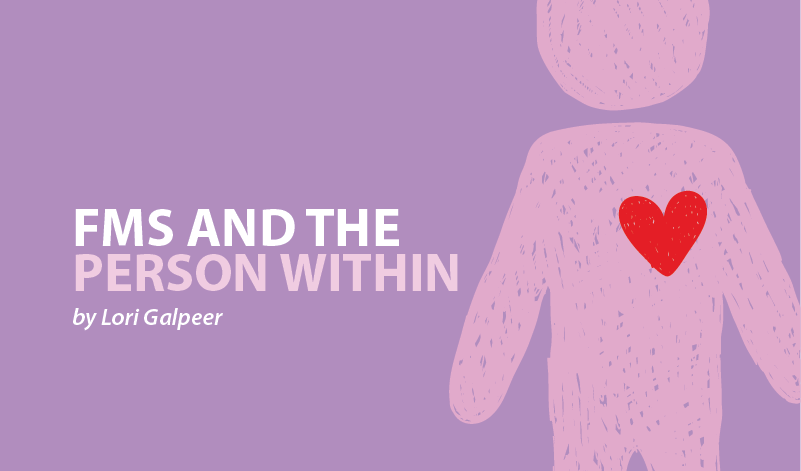
My flares may last for two days or two months, depend on the weather (mainly significant changes in temperature and barometric pressure), and come with distinguishing symptoms and intensity. My flares can be unpredictable.
But, usually, they have predictable features. My flares begin with a centralized, throbbing, achy pain that gradually worsens. The pain seems to center in my torso, mostly near the spinal cord. Sometimes the intensity makes me feel weighed down and exhausted, as if a migraine has taken hold of my entire body. My extremities spasm and have a grinding sensation too. Even though I take (continuous) oral contraceptives as treatment for endometriosis, my flares can sometimes produce mild bleeding.
Everything around me is heightened: sounds are more intense or shrill, smells are strong and unfamiliar, tastes of common foods are different. In winter, my muscles lock up easily, and those of the trigger point area of the shoulders and neck are most affected. The muscles feel tight and rigid so that I can only walk at a certain pace, and the more I walk, the tighter the muscles become. In extremely cold temperatures, my muscles almost feel as if they will rip. In summer, humidity leads to a burning pain similar to the blistering sunburns of my childhood before sunscreen was introduced.
Just as I became familiar with these forms of pain, I encountered a new form in 2015, when I determined to push through a mild flair and take small walks every day, as opposed to every other day. My body responded with a vengeance. I developed a pain difficult to put into words; the closest description is a type of electrical charge mixed with a gripping pain. This was highly disconcerting. I already had lost enough control over my health and a flair’s onset, now I was adding yet another type of pain to the list.
This change was a reminder to myself to be cautious, of the fine line between functioning while in a flare and overdoing it. Thankfully, my flares are usually just a couple of days, and even though the current one started in mid-December, I know it will not last forever. I do what I can to comfort myself: soft blankets, lots of pillows, and favorite TV sitcoms. I use aromatherapy and practice visualizing pain reduction, and do not think about the chores I am missing, or the fact that I have to spend much of the day in bed.
As I am sure most of you also do, I hold off on taking added medication until the pain is unrelenting. My reason is a mix of not wanting to inundate my liver, and of thinking that somehow I am softening if I take a medication too soon. (For me that’s an anti-epileptic/muscle relaxant.) Most of all, I have learned to resist feeling guilty about having to pamper myself, or of being unable to do certain tasks for a while. Usually, this is easiest with the harshest flares, when I couldn’t care less about the world around me. Others can try to make you feel bad about the way you’re dealing with this illness — you don’t need to be your own worst enemy, too.
Note: Fibromyalgia News Today is strictly a news and information website about the disease. It does not provide medical advice, diagnosis, or treatment. This content is not intended to be a substitute for professional medical advice, diagnosis, or treatment. Always seek the advice of your physician or other qualified health provider with any questions you may have regarding a medical condition. Never disregard professional medical advice or delay in seeking it because of something you have read on this website. The opinions expressed in this column are not those of Fibromyalgia News Today, or its parent company, BioNews Services, and are intended to spark discussion about issues pertaining to fibromyalgia.


Lori, I really enjoyed reading your article. Spoonie friends for life ?
Big (gentle) hugs back to you Robin! <3
Your article showed a great deal of what we go through on a daily basis. Thank you! My pain is always there. (It’s just a matter of how much, how bad and where.) One thing I did learn from one of my many doctors – two years after being prescribed muscle relaxers from another doctor – was to take the muscle relaxers on a regular schedule. I used to wait until I couldn’t stand the pain anymore. Then I would take it. OOPS! Wrong directions. I found out from the second doc and my pharmacist that you’re supposed to take them upon awakening and on a REGULAR schedule, whatever that may be for you, in order to “get in front of the pain.” Otherwise, you’re just “chasing the pain.” And the medication doesn’t work as well. So, I started doing that and it made a HUGE difference! Please check with your doctor and pharmacist as to how and when to take the medications you’re prescribed. The pharmacists know a lot more about the drugs as they deal with them exclusively. They can not only tell you when to take it, but what not to take along with it and whether taking it on a full or empty stomach is best. Had the first doctor told me the correct way to take them, I know I would have been spared some really unrelenting pain for those first couple of years!
Thanks for the important reminders; I do take the necessary pain meds (antidepressant; opioid derivative) regularly, I was referring to the muscle relaxant I take for pain that is designated for nighttime . . I did realize that taking part of it earlier in the evening has helped on days I overextend myself or sudden onset of heightened pain, so that I am not in extreme pain by ‘designated’ bedtime. the other pain reliever Alleve, I only take when my shoulder/neck combination is acting up in hopes of deterring the eventual headache. I learned from my husband, who suffered back/neck injury many years ago, that I found myself telling him to not wait until gets too bad, and realized I too carried the same mentality on those 2 meds. Thanks for mentioning for many may think this way too and don’t want them to follow in my footsteps of waiting too long.
Dear Lori, my heart goes out to you. Reading between the lines, I sense your continued struggle with accepting your inability to function at the pace you were once so accustomed to. For the past 20 yrs I have been unable to work at the career I fought so hard to build . . . at times, I am still unable to accept/respect my limitations. (I am now in my 60s) I, too, have a beloved canine who seldom leaves my side. Your story is “our” story. Sending blessings of perfect temps, cashmere blankets, and well written scripts You are not alone.
You are not alone.
You are quite astute, or it is more apparent than I realized . . it is very hard, as we all have to adjust to giving up facades of our pre-FMS selves. I still keep hope that a better treatment will enable all of us to function on a more consistent basis, thus, being able to resume some parts of our past lifestyle. Thank for kind sentiment – same for you too; glad you have a canine companion to share the experiences with and provide some comfort and unconditional love.